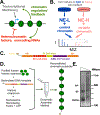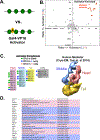SILAC-MS Profiling of Reconstituted Human Chromatin Platforms for the Study of Transcription and RNA Regulation
- PMID: 30192551
- PMCID: PMC6537104
- DOI: 10.1021/acs.jproteome.8b00395
SILAC-MS Profiling of Reconstituted Human Chromatin Platforms for the Study of Transcription and RNA Regulation
Abstract
DNA packaged into chromatin is the core structure of the human genome. Nearly all eukaryotic genome regulation must interface with this genomic structure, and modification of the chromatin can influence molecular mechanisms that regulate the underlying DNA. Many processes are governed by regulated stepwise assembly mechanisms that build complex machinery on chromatin to license a specific activity such as transcription. Transcriptional activators drive the initial steps of gene expression, regulated in part by chromatin. Here we describe tools to study the stepwise assembly of protein complexes on chromatin in a highly controlled manner using reconstituted human chromatin platforms and quantitative proteomic profiling. We profile the early steps in transcriptional activation and highlight the potential for understanding the multiple ways chromatin can influence transcriptional regulation. We also describe modifications of this approach to study the activity of a long noncoding RNA to act as a dynamic scaffold for proteins to be recruited to chromatin. This approach has the potential to provide a more comprehensive understanding of important macromolecular complex assembly that occurs on the human genome. The reconstituted nature of the chromatin substrate offers a tunable system that can be trapped at specific substeps to understand how chromatin interfaces with genome regulation machinery.
Keywords: Mediator; RNA tethering; RepA; SILAC; TDP-43; Xist; activator; chromatin; lncRNA; transcription activation.
Figures



References
Publication types
MeSH terms
Substances
Grants and funding
LinkOut - more resources
Full Text Sources
Other Literature Sources

